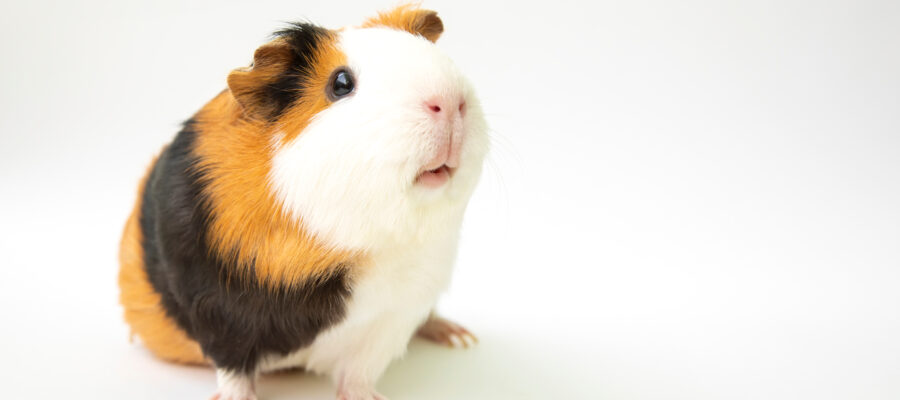How to Care for Your Guinea Pigs

By Patricia Thomblison, DVM, MS
Guinea pigs, also known as cavies, are sociable creatures that make great pets. They prefer to have companions and it’s not unusual to fall in love with them and have multiple pigs creating a “herd”. In the wild they usually live in herds of 10 or more. You may not want to take on that large a group, but it is important to have more than one. Guinea pigs typically weigh 1 to 3 pounds and come in a many colors including: white, cream, tan, reddish brown, black, or a combination. The American Cavy Breeders Association recognizes 13 breeds that it divides into groups or varieties. The most common are recognized by hair type: American (short, smooth hair); Peruvian (long, silky hair); and Abyssinian (whorls of unruly, rough hair).
WHAT DOES MY GUINEA PIG NEED?
Cage Size
Since guinea pigs spend so much time in their cages it’s a good idea to get one as large as you can. One or two guinea pigs need a minimum of 7.5 square feet but larger is better. These larger spaces are easier to clean because they prevent the buildup of waste and allow the guinea pigs to separate their bathroom area from other activities.
Bedding
The main function of bedding is absorb moisture from feces and urine. This slows bacterial growth and reduces the formation of ammonia, carbon dioxide and harmful bacterial toxins. It should be spot cleaned daily and changed completely every 3 or 4 days. There are several types of bedding available but avoid cedar chips and wood shavings.
Toy Enrichment
Guinea pigs enjoy several types of toys, and a regular rotation can prevent boredom. They like and need to chew, explore, and hide, so suitable toys include paper bags, paper towel rolls, tunnels, and hideaways. There are several commercially available toys, but do not use balls or exercise wheels as guinea pigs may hurt themselves.
Feeding Guinea Pigs
Guinea pigs are herbivores, have a high metabolism, and, just like people, need Vitamin C in their diet or they will develop scurvy. A large part of their diet should be a good quality hay such as timothy to provide them necessary roughage. They can be fed small quantities of a high-quality pellet and vegetables. Some vegetables they are especially fond of are carrots, lettuce, and parsley. Don’t change what you are feeding rapidly and introduce new foods slowly. If you use Vitamin C drops in their water, change and mix it daily as it degrades quickly.
HEALTH CONCERNS
Guinea pigs tend to hide their symptoms if they are not feeling well. Their eyes should be open and clear. Breathing should be easy and quiet, and they should be able to move about without lameness. They are susceptible to several bacterial, viral, parasitic, and fungal diseases. Your veterinarian can help you monitor their health by checking for diseases, their weight, listening to their lungs and heart, and examining their teeth to make sure they aren’t overgrown. It is unusual for a guinea pig to not eat, so if your pet goes without food a trip to the veterinarian is warranted.
Skin and Haircoat
Skin and haircoat are especially vulnerable to disease that you can see. ZYMOX® for Small Animal & Exotics Topical Spray and Topical Cream can aid in the management of many of these common conditions. ZYMOX products are non-toxic and have been shown to be effective on bacteria and fungus. What’s more, they don’t contain any antibiotics or corticosteroids.
Here are some special things to look for and ways to help.
Urine scald
- Looks like red swollen skin between the back legs.
- This can be the result of urinary tract infections or limited mobility. Treat the skin and look for the underlying condition.
Irritated ears
- Redness or a discharge from or around the ear may indicate an ear infection.
- If only the outer ear is affected topical treatment may be helpful. If infections persist, other treatments should be pursued.
Ringworm
- Look for itchy areas with hair loss, redness or scaling.
- This is common in guinea pigs and contagious to people. Treat with antifungal spray or lotion and be extra careful with hygiene habits.
Wounds or cuts
- If the wound is bleeding, apply pressure with a clean gauze pad or towel.
- For deep or infected, take your guinea pig to the veterinarian as soon as possible. If it is superficial, keep the area clean and apply a topical cream or spray, like ZYMOX.
Bumblefoot
- The footpads are red and swollen, may have sores or become overgrown.
- This occurs most frequently when the guinea pig is overweight or are walking on a rough surface. Make sure their nails are trimmed so their walking pattern is uniform. Keep the feet clean and make sure the bedding is appropriate. Use a cream or spray to decrease the risk of infection.
As with any health condition, be sure to check with your veterinarian for proper medical care.
ABOUT THE AUTHOR
 Click here to read more about Dr. Patricia Thomblison
Click here to read more about Dr. Patricia Thomblison

